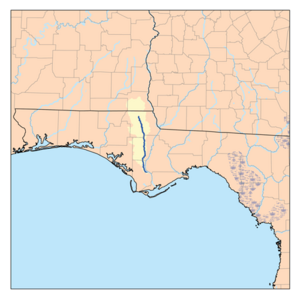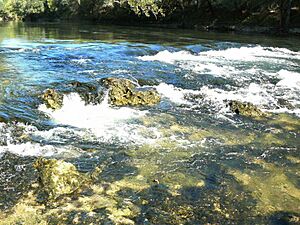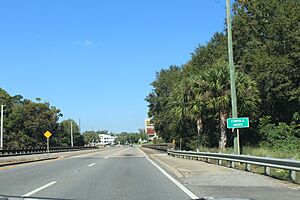Chipola River facts for kids
The Chipola River is a beautiful waterway in western Florida. It's like a smaller stream that flows into a much bigger river, the Apalachicola River. Think of it as a branch joining a main tree trunk! The Chipola River is an important part of the ACF River Basin, which is a huge area where all the rain and water eventually flow into the Apalachicola, Chattahoochee, and Flint rivers.
This river stretches for about 92.5 miles (149 kilometers). It winds its way through three different counties in Florida: Jackson, Calhoun, and Gulf counties.
Contents
Exploring the Chipola River
The Chipola River is known for its clear waters and natural beauty. It's a great place to explore and learn about Florida's environment.
Unique Features of the River
The Chipola River has some special features that make it stand out.
Rapids and Springs
Even though Florida is mostly flat, the Chipola River has some exciting spots! In some areas, you can find small rapids, which are like mini-waterfalls where the water flows quickly over rocks. The river also gets its water from many natural springs. These springs are places where fresh, cool water bubbles up from underground.
The Dead Lakes
One of the most interesting parts of the Chipola River is the area known as the Dead Lakes State Recreation Area. Just before the Chipola River meets the Apalachicola River, it flows into these unique lakes.
The Dead Lakes were formed a long time ago in a very cool way. The Apalachicola River, which is much larger, carried a lot of sand. Over time, this sand built up and created natural barriers, like sand walls, that blocked the mouth of the Chipola River. This caused the water to back up and spread out, forming the wide, shallow lakes we see today. The name "Dead Lakes" comes from the many cypress and tupelo trees that were flooded when the lakes formed, leaving their "dead" trunks sticking out of the water.
River's Journey to the Sea
After flowing through the Dead Lakes, the Chipola River continues its journey south for several miles. It runs almost side-by-side with the Apalachicola River. Finally, the two rivers meet and join together. This meeting point is called a confluence. From there, their combined waters flow all the way to the Gulf of Mexico.
What Lives in and Around the Chipola River?
The Chipola River and its surrounding areas are home to many different plants and animals. The clear water and natural environment provide a perfect habitat for wildlife.
River Animals
- Fish: Many types of fish live in the river, making it a popular spot for fishing.
- Turtles: You might spot different kinds of turtles sunning themselves on logs or rocks.
- Birds: Various birds, including wading birds like herons and egrets, can be seen along the riverbanks, looking for food.
- Other Wildlife: The forests around the river are home to deer, raccoons, and many other creatures.
Fun Activities on the Chipola River
The Chipola River is a great place for outdoor adventures.
- Boating and Kayaking: Its calm sections are perfect for paddling a canoe or kayak, allowing you to explore the quiet beauty of the river.
- Fishing: Anglers enjoy fishing for the various species of fish found in the river.
- Exploring Nature: The Dead Lakes State Recreation Area offers trails for hiking and opportunities to observe wildlife in their natural habitat. It's a wonderful place to connect with nature and learn about Florida's unique ecosystems.
The Chipola River is a true natural treasure in Florida, offering both beauty and a chance to learn about river systems and wildlife.




